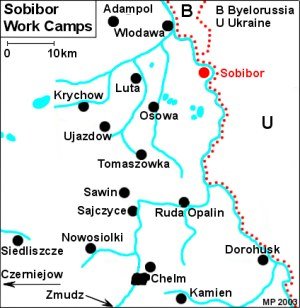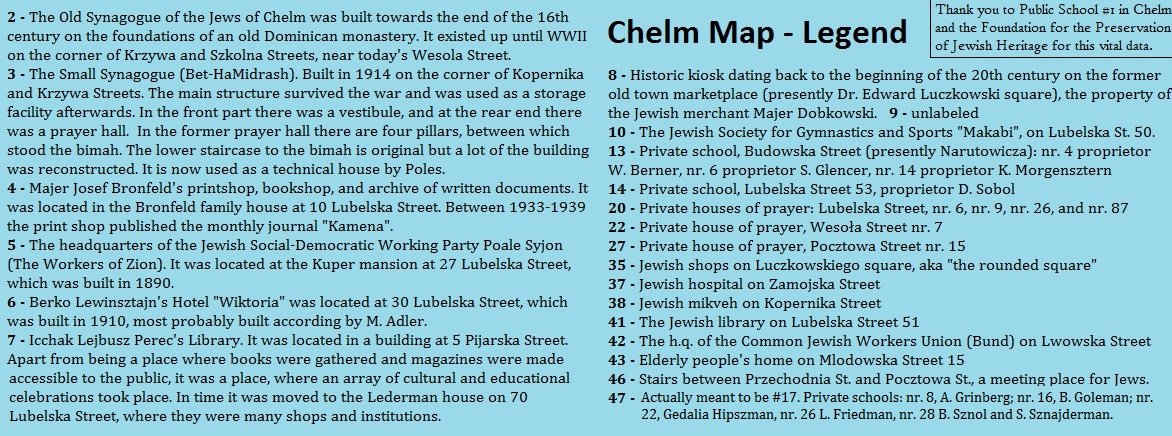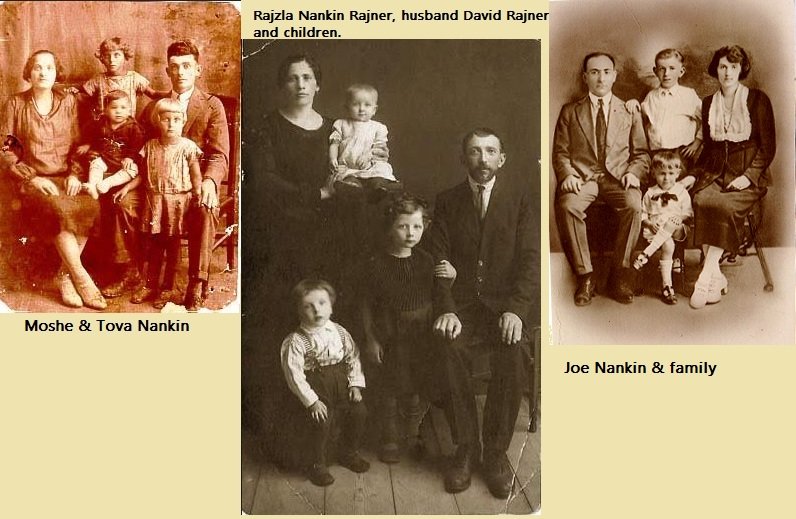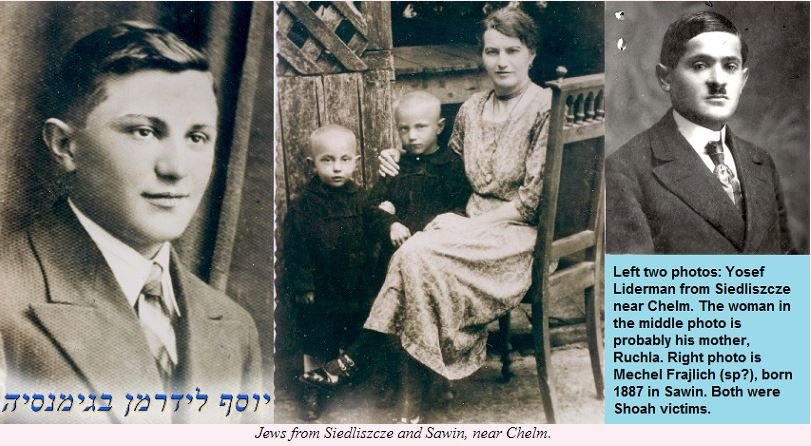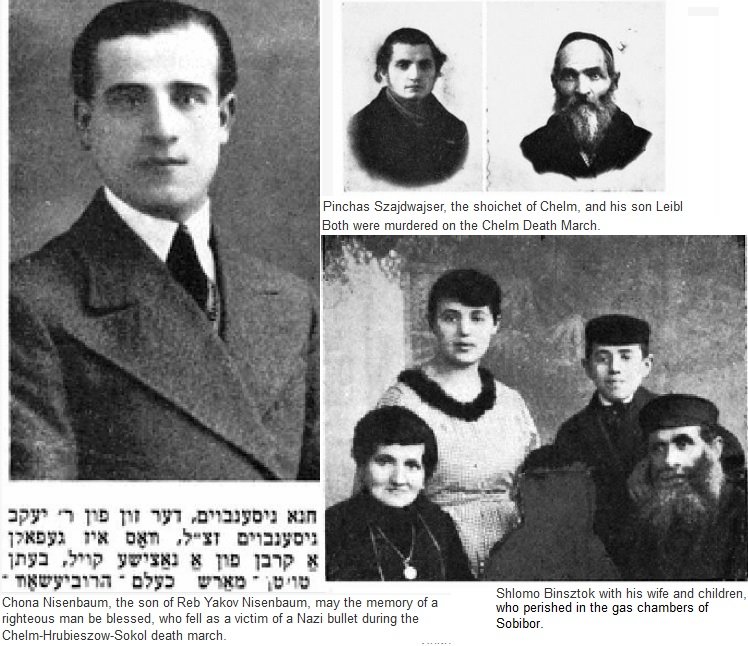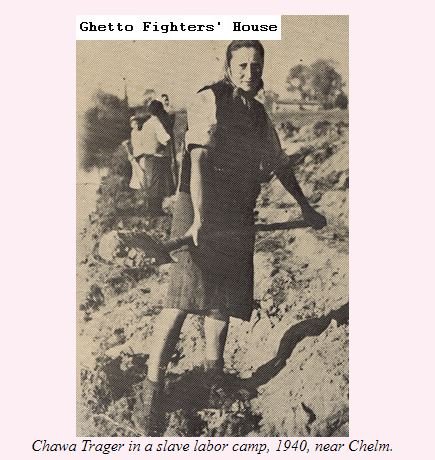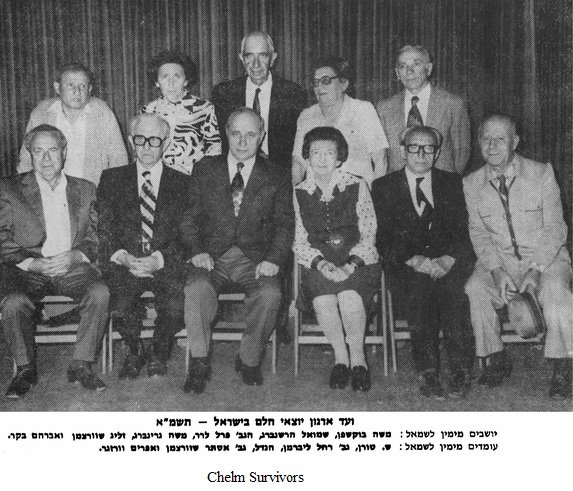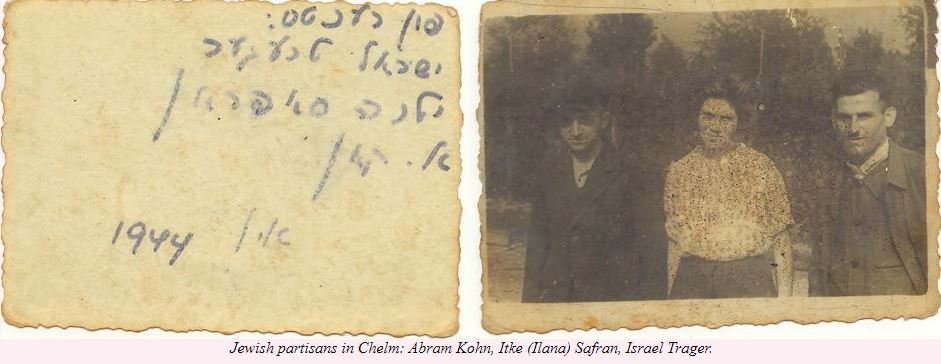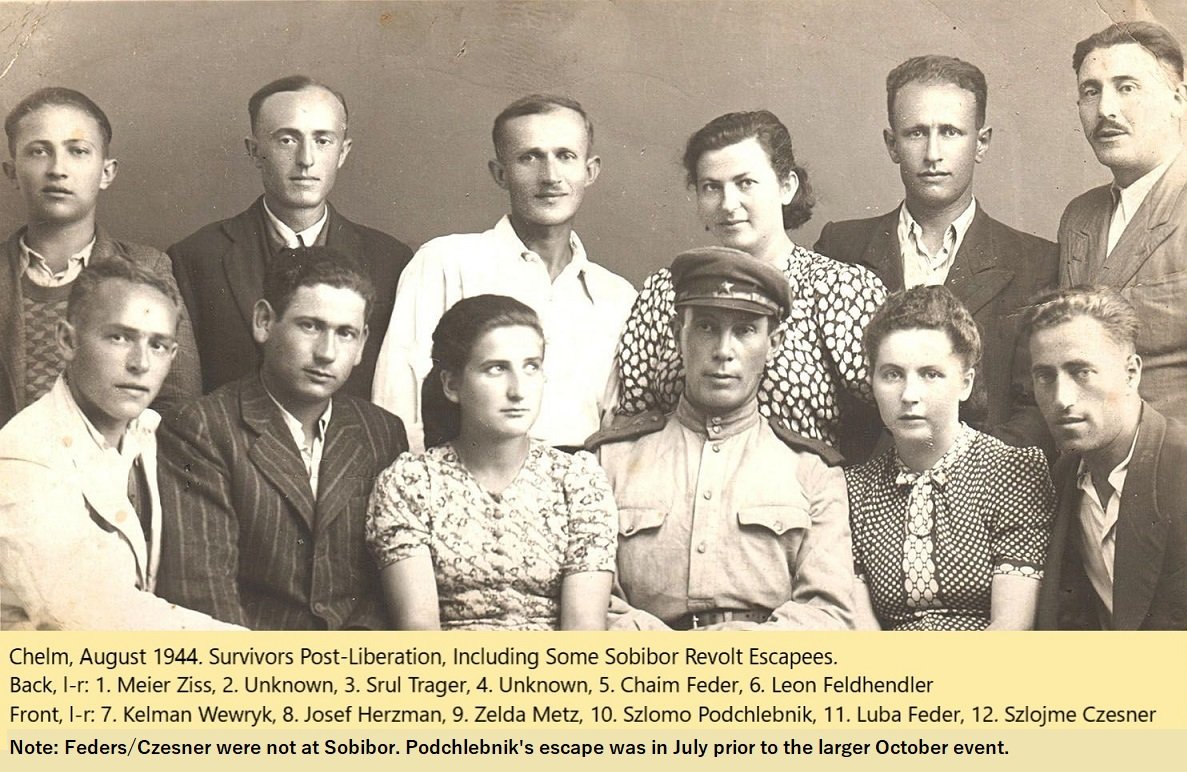Remember Jewish Chełm
"All roads lead to Chelm,
All the world is one big Chelm."
- Isaac Bashevis Singer
HISTORY OF JEWISH CHELM
Chelm is located in southeast Poland and has a current population of 67,700. The city is southeast of Lublin, north of Zamosc, and 25 km. from the border with Ukraine. The first mention of Jews living in the city is in the 14th Century. The first Jews arrived in Chelm was in 1205. By 1630 the Jewish population was 30% of the total city population. From 1648 to 1657, there was a Cossack war of liberation from Poland called the Khmelnytsky Uprising, during which 400 Chelm Jews -- approximately 75% of the population at the time -- were killed. Most Jewish Ukrainian communities were devastated by the uprising and ensuing massacres.
The community had been revived by the beginning of the 18th century, when the Jews of Chelm played an important part in the export trade. The Jewish community numbered 1,500 in 1765, 1,902 in 1827, 2,493 in 1857, 7,226 in 1897, 13,537 in 1931, and more than 15,000 in 1939. The Jewish population in 1921 was 12,064 out of 23,221 total. By 1939, the Jewish population rose to more than 15,000. Chelm was highly regarded as a center of Torah study in Europe.
The region of Chelm-Belz sent delegates to the Council of Four Lands in 1677, 1711, 1724, and 1762. In some of those years it was the Chelm-Zamosc delegation. In 1880, a train line was established between Brisk and Chelm, and later the line included Wlodawa. Among the business operations in Chelm were: oil works, which belonged to Kalman Frydman; the tannery owned by Szlomo Szajer; and two workshops manufacturing brass articles owned by Chil Uger and Pinkas Lew. Later on, dentists Dwojra Lorber, Chana Birenbaum and Chaim Liszczyn had their own practices. There were three pharmacies in town, run by Jakub Horowitz, Szloma Birenbaum and Berek Gutharc. Printing houses were operated by Wajnsztajn, Josef Bronfeld and Erlich. Before the outbreak of WWI, the community owned one synagogue, a house of prayer, six religious schools, two mikvot and a cemetery. The kehilla financially supported the orphanage at 80 Lubelska Street and an old people's home. An amateur Jewish theatre was active in the town. Newspapers in the town were the Unsere Shtime, the Chelmer Folksblat weekly, and the Unser Tsukunft daily.
Houses of prayer (cheders) were operated by W. Berger at 6 Budowska Street; S. Glencer at 4 Budowska; H. Moncarz at Podwalna; David Sobol at 53 Lubelska; B. Bibel at 11 Pokrowska; M. C. Oksman at 24 Pokrowska Street; P. Buksman at 11 Siedlecka; S. Grinberg at 19 Siedlecka; I. Lejber at 15 Siedlecka L. Friedman at 26 Pocztowa Street; G. Hipszman at 22 Pocztowa Street; A. Nuclack at 7 Seminarska Street; B. Goleman at 16 Pocztowa Street; K. Morgensztern at 14 Budowska Street; A. Ochman at 6 Seminarska; B. Sznol at 28 Pocztowa; I. Recter at Pocztowa; A. Grinberg at 8 Pocztowa; M. Sztajnberg at 7 Seminarska; J. Sznajderman at 7 Seminarska; S. Sznajderman at 28 Pocztowa Street; and A. Zak at Pocztowa Street.
In Chelm, a Talmud-Torah school was founded in 1922 and located at Mlodowskiej 15 and a Beit Yaakov school for girls was also created. In 1915, a common school for Jewish children, led by Klara Morgenstern, was created. It was located at Budowska 14 (now Narutowicza). There was also a Tarbut school. Starting in 1918, the Jewish community had its own co-educational gymnasium at Budowska 9. The leader of the school was Edward Fuhrman and other teachers were: Hersz Friedman-Reinbarz, Yaakov Jakub Heiter, Maria Heiter-Oberfeld, Anna Hoffmann-Taaska, Kazimierz Jaworski, Gustaw Gerson Mandelkiern, Klara Mandel-Corps, Moses Morgensztern, Debora Rottenstreich, Adam Sunderland, Jakub Zinneman, Jakub Grynberg (secretary), and Doctor Yaakov Iwry. In 1919, the Chelm Library was founded and located at Pijarska 5. In addition to collecting books and creating magazines, it also organized cultural and educational events. In time it was moved to Lubelska 70.
The influential conservative religious party Agudas was founded in Chelm in 1931 by Anszel Biderman. The Bund Workers Union was established in Chelm around 1917. Srul Frajd (carpenter) and his brother Mordko, Moszko Szimel, Perec Szyfer, Bajla Traist, Majer Guss (Hus) and Chava Tuchman were active in the local chapter of the Bund. The Tarbut Jewish Cultural and Educational Association, a Zionist school organization, was based in Chelm on Narutowicza Street 14.
In 1934, the newly elected Town Council was composed of 20 Poles and 12 Jews. In 1936, in the Board of the Jewish Community of Chelm had 5 Orthodox representatives: Judka Mendelson, Abram Frydman (labourer), Anszel Biderman (real estate owner), Jankiel Korenblit (merchant) and Szymon Sajkiewicz (merchant). Poale Zion-Left introduced three of its representatives to the Board: Mordko Ela Goldman, Chaim Jankiel Bekier (upholsterer) and Berysz Akselrod (teacher). Local Zionists were represented by Abram Aron Szajn, while the Revisionist Zionists by Szyja Tenenbaum.
Before World War II, the Jewish Merchants Association was operating in Chelm at Lubelska 47 and was led by the notable Chelm industrialist Isaac Lederman. The Intellectual Club in Chelm met at Bella Lewensztajn's house, Lubelska 8. The Jewish Social Club was located at Lubelska 70 in Chelm. A branch of the Jewish Health Care Society (TOZ) in Chelm was located at 6 Sienkiewicza Street.
The Jewish charities Linas ha-Cedek and Committee for Helping the Poor existed. The charitable organization Hachnasat Kala, which collected funds for wedding and dowries for poor Jewish bridesmaids, operated at Uscilugskiej 13. The Hachnasat Orchim Organization, which was providing aid to traveling Jews, was based at Mlodowska 15a. The charitable organization Gemilut Chesed also existed. The
Malbisz Arumim Association, which provided poor Jewish children with shoes and clothing, had its headquarters in Chelm at Uscilugskiej 13. The Chelm Bikur Cholim Society supported the sick.
In 1916, at the initiative of I. Achtman, N. Goldfaden, J. Rozenblat and I. Zygielbojm, a Jewish dramatic circle was established in Chelm. There was also a Jewish Students' Choir in Chelm, which was especially supported by the Zionist organizations in the city. A chess club was established in 1914 by S. Eliasberg, Sz. Farber, M. Sekular, A. Dajzman, Ch. Cegelman and E. Erlich. In 1927, the Jewish Gymnastic and Sports Association "Makabi" was established. There were sections for tennis, gymnastics, and other athletics. It was located at Lubelska 50. The Jewish Sports Club "Jordan" operated in Chelm between 1925 and the Holocaust. It included swimming and athletics sections.
The Chelm Jewish community population in 1939 was 15,500. Nearby communities included:Andrzejow (40 Jews), Bukow (30 Jews), Busowno (15 Jews), Chutcze (100 Jews), Dorohusk (430 Jews), Jozefow in Chelm County (6 Jews), Kanie (20 Jews), Liszno (45 Jews), Lukowek (Jewish population unknown), Radzanow (20 Jews), Rejowiec (3,500 Jews) Ruda Huta (250 Jews), Ruda Opalin (25 Jews), Sajczyce (Jewish population unknown), Sawin (882 Jews), Siedliszcze (1,500 Jews), Sielec (250 Jews), Staw (25 Jews), Swierze (800 Jews), Uhrusk (100 Jews), Wojslawice (1,200 Jews) and Zarzecze (100 Jews). The Jews in these communities were largely murdered in the Shoah.
CHELM DURING THE HOLOCAUST
The Chelm Ghetto was established in 1940 and lasted until November 15, 1942. It included ~11,000 Jews from Chelm and 2,000 from Slovakia. The street borders of the ghetto were: Lwowska, Uscilugska, Wojslawicka, Partyzantow and Pocztowa. Nazis took over the city on Oct. 7, 1939 and immediately initiated a series of pogroms in which scores of Jews lost their lives. Included in these massacres were executions of Jews at the cemetery. On Dec. 1, 1939, 1,800 Jewish men from Chelm and nearby Hrubieszow between the ages of 15 and 60 were driven in a death march to the Soviet-held town of Sokal. En route, 1,400 of the men were shot. Only 150 survived. Judenrat members in Chelm county included Anshel Biderman, Mechel/Mejer Frenkel, unknown Dreszer, Arie Frajberger, Dr. Maurycy Kleinhaus, Szaja Tenenboim, Dr. Eliyahu/Eliasz Tisch, Mordko Rajz, Szaja Zylberman, and Pinchos Szwarcblatt.
On 31 May 1941, 1,800 Jews from Chelm were forced to work on road/railway construction projects, in forestry labor, at a quarry, at a sawmill in Zawadowka, and for the military. Another 250 Jews from Chelm were interned at labor camps, the majority at a camp established by the Inspectorate of Water Regulation (Wasserwirtscharfsinspektion) in Kamien. In June 1941, 100 additional ghetto
residents became the first inmates of another Water Inspectorate camp, established in Chelm for the purpose of reclaiming swampland. Another 1,440 Jews from Chelm performed forced labor each day at a forced labor camp in Chelm, where they worked on land renewal. Some Jewish women worked as domestic servants for German civilian and military authorities, while men worked on public works projects, unloading coal at the railway station, removing gravestones from the Jewish cemetery to use as pavement, and extending the municipal water system. In April 1942 -- after Aktion Reinhardt was developed -- many able-bodied Chelm Jews marched to Wojslawice, Sawin, and other places in the Chelm district for slave labor.
A vast network of labor camps were set up in and around the Chelm area. Jewish slave labor was used at these locations, and few Jews survived the sadistic conditions of them. Among the labor camps were: Bialopole Labor Camp, Busno Labor Camp, Kanie Labor Camp, Kulik Labor Camp, Liszno Labor Camp, Rejowiec Labor Camp, Zawadowka Labor Camp, and a group of labor camps near Wlodawa (Adampol, Hansk, Holeszow, Horodyszcze, Rossosz, Swidnik, Swierze, and Ulany). Additionally, many Jews from Chelm were transferred to the Sobibor sub-camps of Dorohusk, Dorohucza, Kamien, Luta, Nowosiolki, Ossowa, Ruda Opalin, Sajczyce, Sawin, Siedliszcze, Staw, Trawniki, Ujadzow, and Zmudz. Those who did survive these camps were ultimately sent to the gas chambers at Sobibor.
Prof. Stanislaw Batawia of Poland says that the Chelm Lubelski Hospital patients -- including 128 women, 304 men, and 18 children -- were shot on the hospital grounds, and then mass-buried under the eyes of the Polish hospital staff in Jan. 1940. The S.S. wanted the hospital for its quarters. The Chelm Jewish community, until 1942, was working to support its destitute members in an impossible situation. By late 1941, the Jewish community had established three community kitchens, a medical clinic, and a 25-bed hospital for infectious diseases. After a typhus epidemic in November of 1940, the medical staff in Chelm were caring for 6,828 impoverished community members.
In December, 1939, S.S. man Richard Nitsche of Wlodawa sent 50 Jews from that town as hostages to Chelm -- where they were beaten up cruelly and the next day they were allowed to return. Additionally, around 20 Jews from Rejowiec who were found in Izrael Werman's ice cellar were dispatched to Chelm, including Motel Eisenberg with his family, Shimon Derlichman, Avraham Derlichman, Feyge and Avraham Finkelstein, and others.
On April 11, 1942, a deportation of Jews from Chelm to Belzec took place. The 'transport watchers' knew it took place because an empty train returned to Zamosc. The following day, 2,500 Jews were evacuated from Zamosc to Belzec. After this, there was a lull in the evacuations for the rest of April -- probably due to Belzec's limited reception during the reconstruction of gas chambers.
Another mass deportation from Chelm took place in May of 1942, and ~4,100 Jews (including 2,000 Slovakian Jews) were sent to the Sobibor death camp. On October 27, ~3,300 Jews were sent on a forced march to Sobibor, some 50 km. north of Chelm. On November 6, 1942, around 10,000 Jews of Chelm were sent to Sobibor for extermination. Around 500 Jews were left in Chelm at this point, and used for slave labor. Rabbis Gemaliel Hochman and Jehuda Zund Richl were
assassinated in early 1943. Hundreds of Jews were deported to Sobibor again in January and February of 1943. Only a handful of Jewish workers were left in the city's prison; of these, 15 survived and were liberated on July 22, 1944. Several Jews lived in Chelm until the 1950s.
The Nazis destroyed most Jewish buildings, including the synagogue located on the corner of Krzywa and Szkolna Streets. A small synagogue in Chelm was built in 1912 from donations of the Jewish population. In 2006 the synagogue was turned into a Polish bar called "McKenzie Saloon". About 21 houses of prayer in the city were private. Most of them were situated on Adrjanowska,
Lubelska, Szkolna and Wesola Streets. The oldest house of prayer, owned by Fiszel Lowensztajn, stood at 8 Adrjanowska Street and dated from 1852. In 1862 another prayer house that belonged to Mr. Rajtman was established at 2 Siedlecka Street. In the 1880s new prayer houses owned by the families Rozenter, Engel, Wajc, Horowic and Nuwendsztern were established.
The Nazi murderers also killed an estimated 30,000 Soviet Prisoners of War and Italian Prisoners of War and buried them in the Borek woods, near Chelm. Josef Reznik, a Jewish soldier in the Polish Army who had been incarcerated in Majdanek, was forced to bury these victims with 300 other Jews. The Nazis in charge of the deportations and murders in Chelm were Hans Ansel, Hans Augustin,
Adelbert Benda, Hermann Benzler, unknown Berger, Artur Bernat (Bernard) from Silesia, Bielisch (or Max Beulich), Dr. Bohrmann, unknown Braunmiller, unknown Dietrich, Alfred Eggert, unknown Fisher, Dr. Gerecht, Gerhard or Erhard Hager, Claus Harms, unknown Holtzheimer, unknown Horn, Werner Kalmus, Stanislaw Koltun, Johannes Krauz or Kraus, Erich Langer, Karl Leistikow or Leistiko, Rolf Mauer, Ludwig Pruckner, Hugo Raschendorfer, Adolf Reinert or Reiner, Emmanuel Schafer, Schlesinger (Szlesinger), Konrad Schloegl, Erich Scholz, unknown Selch, Eduard Shutt or Schmidt, Bernhard Staszek (Staschek), unknown Steinert, unknown Stoffel, Rudi Theimer, unknown Urban, and Dr. Workman. Hermann Rohlfing was the chief of the death camp in Borek near Chelm during 1943-1944, was responsible for the murders of thousands of Chelm Jews. The Yizkor book mentions Jewish collaborators Bochenski, Feldman, Pinkhassel, and chief of Jewish police Pinchas Szwarcblat(t).
The Chelm cemetery is located at Kolejowa Street and dates back to the 17th Century. Fifty graves are still visible at the cemetery and a memorial has been erected to memorialize the community. In 1935, the caretakers of the cemetery included: Jakub Zalctreger, Abram Szerer, Lejb Lejzerowicz, Bajla Nudel, Menacha Kupfersztok, and Stanislaw Hajczuk. Once a thriving Jewish city, today there is no Jewish population or sign of Jewish life in Chelm.
Please review the site content below. Zachor - We Remember.
------------------------------------------------------------------------
[History] [Surnames and Researchers] [Notable Residents] [Wikipedia - Chelm]
[Holocaust] [Personal Accounts] [Synagogues] [USHMM Photos]
[Books About Lublin District Jewish Communities]
[Unidentified Jews] [Chelm Photo Recovery Project] [Chelm Jewish cemetery]
[Chelm-Hrubieszow-Belz-Sokal Death March] [Yizkor Book - English]
[March of the Chelm Jews to Sokal] [1] [Martyr List (incomplete)] [1]
[Ghetto Uprising] [Pre-War Jewish Property List (incomplete)]
[Yahad-in-Unum Investigation in Staw near Chelm, 2011]
[Photos of Chelm Today] [Family Research in Southeast Poland]
[Chelmer Organization of Israel] [Chelm: Tracing the Lost Shtetl (in Hebrew)]
------------------------------------------------------------------------
Return to Lublin IndexLINKS
Join the Chelm group on Facebook!
City of Chelm:
- Article: A 60 Year Old Treasure is Found in Poland
- Autograph Book from Haya Berger of Chelm (from Eli Morav)
- Book: To Sobibor and Back: An Eyewitness Account
- The Chassidic Route: Chelm
- Chelm Yizkor Books Online (no English) and Chelm Yizkor Book Translation
- List of the Needy in Żmudź County (near Chelm) 9-7-1941 - JDC
- List of Poor Jews in Wola Uhruska Who Received Flour 12-20-1940 - JDC
- List of Poor Jews in Wola Uhruska Who Received American Gifts 12-20-1940 - JDC
- List of Recipients of Foodstuffs, Clothes from Americans in Siedliszcze near Chelm 7-28-1940 in Yiddish - JDC
- Foundation for Preservation of Jewish Heritage: Chelm
- Sobibor Sub-Camps: The Lublin Waterworks Labor Camps
- Yizkor Book Wojslawice near Chelm
- Zydzi w Chelmie (Book, 2010)
- There were two Chelm shuls on the lower east side of Manhattan: Chelmer Erste Congregation, with 27 members;
... President, Baruch Rosenbaum; Secretary, Gabriel Raiff; and
- Shomrei Ha-dath Anshei Chelm, 22 members + cemetery. President Alter Saltz, born 1877.
- List of Chelm Surnames Buried in NYC Plots
- Mount Pleasant Cemetery (Duvernay, Quebec)
Families of Chelm:
- More unidentified people
- Baum family
- Berland family
- Binstock family
- Boden family
- Boxer family
- Blumenfeld family
- Brucker family
- Czesny/Czesner family
- Elster family
- Erber family
- Fishbein family
- Gaum family
- Gipsz family
- Goldman family
- Grynbojm family
- Horowitz family
- Korenzyer family
- Lazer family
- Lender family
- Lorber family
- Milchtajch family
- Mitzflickier family
- Morgenstern family
- Nisenbaum family
- Schwartz family
- Shargil family
- Stein family
- Szpic family
- Szuchmacher family
- Trager family
- Winnick family
- Zak family
- Zilberman family
- Zimmerman family
- Zisman/Zysman/Zussman family
- Zyskind family
Majdan Tatarski Ghetto Victims (Lublin) from Chelm:
Lejzor Barenholc
Hesia Barenholc
Estera Szajndla Bromberg
Golda Edelsztajn
Zelman Feld
Salomon Goldberg
Sara Goldberg
Sura Rywka Herszenhorn, nee Listinger
Fiszel Herszenhorn
Cyrla Honigman
Mendel Horowicz
Sura Rywka Lerner
Towij Liberman
Chaim Prymer
Moszko Josef Rozen
Kiwa Rozen
Lea Rozenberg
Munysz Szporer
Cysia Zajdensznir
(source: Brama Grodzka - Teatr NN)
Rabbis of Chelm:
- Judah Aaron, 1522
- Elijah Ba'al Shem ben Judah Aaron, 1570-1583
- Moshe HaCohen Adamchyk (Adamaszek)
- Szymeon Auerbach
- Shlomo of Chelm
- Binem Dychter
- Samuel Eidels, 1606-1615
- Yitzhak Hochgelernter
- Gemaliel Hochman
- Gawriel Hochman
- Hershel Jozefowicz
- Josef Kahan, 1910-1918
- Abram Birkan
- Shlomo Yehuda Lederer
- Abraham Leiner
- Gedalia Leiner
- Chaim Nuta Mandelbojm
- Yehuda HaCohen Mendelson
- Yehuda Lejb Milner
- Josef Mincer, 1890-1903
- Israel Najhojz
- Majer Najhaus (Meir Neuhaus), 1922-unknown
- Yakov Nisenbaum
- Avraham Menachem ben Moshe Twersky
- Piney Szaijdwajser
Survivors of Chelm:
Note: Additional survivors listed in Pinkas HaNitzolim II and Chelm Jews Escape from the Borek Forest
Rojza Agres
Shlomo Alster
Leon Applewhite
Abram Avtiglitz
Anna Bankierer Friedman
Felicia Berland Hyatt (testimony)
Chana Binsztock
Fajga Binsztock
Felus Birenbaum
Chana Bitman
Ludwig Borenstein
Wolf "William" Borenstein
Jankiel Burstyn
Yaakov Bursztajn
Chava Cherniak Biber (testimony)
Indyta Cosnac
Bajla Czesner Szerer
Berko Czesner
Liba Czesner Rubinstein
Malka Czesner King
Moshe Czesner
Nuta Czesner
Shlomo Czesner
David Guss
Leon Cymiel
Zygmunt Czerniakowski
Bessie Drecksler Punsky
Edward Dunietz
Rachel Ejber Birnbaum
Yehoshua Epstein
Rose Farbiarz
Leon Fejgenbaum
Celia Feldman Bankirer
Esther Feldman Icikson
Motel Friedman
Saul Friszman (Fryszman)
Fajga Fruchter Zernitsky
Aharon Fruchtman
Yisrael Fruchtman
Jack G.
Mosze Ganc
Nella Gelberg Juffe
Baruch Gelerman
Baer Geller
Fira Geller Silberbach
Sarah Geller Akerstein
Ela Globen
Arie Goldberg
Bernice Goldman Stemer
Szlema Goldman
Solem Goldman
Szulim Goldman
Zelik Goldman
Sylvia Greenspan (video testimony)
Miriam Grinwald
Fajga Handelsman (went to Israel)
Ester Hertz (video testimony)
Chaia Hertz
Szaja Sydney Herc (Hertz)
Tova Hertz
Tauba Herz Binstzock (went to El Salvador)
Wladyslaw Iwaszczukiewicz
Mary Jannol
Chaim Kac/Katz
Jacob Kachaner
Ethel Karp
Hanka Kent (video testimony)
Miryam Krajzel (Krayzel)
Jacob Kuperblum
Genia Laks
Ryszard Lecinski
Tsilah Lentsiski
Simon Libhaber
Ester Rywka Libhaber
Rachel Lichtman
Tsivia Korenzyer Levy
Esther Ajzen Lewin
Jonah Lotan
Josef Milner (went to El Salvador)
Abraham Mitelman
Icek Mitzflikier (Micflikier)
Moshe Mitzflicker (Micflikier)
Abraham Nachman
Dawid Nankin
Morris Nankin
Samuel Nonkin
Yehuda Nudel
Maria Ochlewska (born Estera Horn)
Sara "Sheila" Perec Bernard Etons
Marsha Raubvogel
Chuma Rendler, aka Natalie Gonenn
Samuel Rendler
Sonia Ribeizen Hurgin
Renata Sobel Reisfeld
David Rolnik
Hala Rosenberg
Phyllis Rosenberg
Sara Rozen, aka Christine Damski
Motel Rozenkopf
Chana Salzman
Hersz Schechterson
Jacob Schmaltz
Rubin Shafran
Josef Sierczuk (Serchuck)
Alex Silber
Simcha Silberblech (Simon Silver)
Ella Smolarz
Dysia Sonenreich
Mala Steinberg
May Szerman Kaplan
Henry Sztokfisz (Stockfish)
Tova Szulklaper
Lejba Szyf (went to Belgium)
Alter Benzion Terner
Rose Toren
Lenia Torn
Israel Srulke Trager
Natan Warman
Sol Warsager
Menajza Weit
Chaim Wertman/Wortman
Dr. Naum Wortman
Kalmen Wewryk
Maina Wilenko
Ajdla Wojentrajter
Aaron Yermus
Mimi Yurfest Kanner
Abraham Zernitsky
Ruchla Zimmerbaum
Efraim Zinger
Survivors of Rejowiec
Survivors of Sawin
Survivors of Siedliszcze:
Sonia Epelstein
Regina Feldman Zielinska (video testimony)
Ruta Goldman
Golda Horn
Zelda Kelberman Metz
Yehuda Idel Terner
Esther Terner Raab (video testimony)
Survivors of Wierzbica:
Zelda Berezniak
Ben Hochman
Josef Hochman
Sala Szteinberg
Survivors of Wojslawice:
Estera Dafner Tenenbaum
David Eines
Leibel Eines
Shabtai Eines
Szandla Fierman Wagenfeld
Mirla Gutmark
Rachel Gertz
Avraham Hendler
Rabbi Shlomo Hochler
Fajwel Hochlerer
Mordechai Kalmanowitz
Shimon Kanc
Aleksander Kasha
Israel Kelner
Moshe Kleinminc
Rivka Luden
Shlomo Ofir
Moshe Rab
Yitzchak Irving Raab (Rab)
Lejb Rejs
Luba Schmaltz
Moshe Strassberger
Yakov Zisman (Sussman)
Notable Residents of Chelm:
Full Listing: Notable Residents
(Note: Full listing excludes those listed below.)
Joseph Finklestone
Leon Fleischer
Tzipora Livneh
Rabbi Baruch Rabinowitz
Rabbi Yehuda Leib Rabinowitz
Professor Renata Reisfeld
Rose Schneiderman
Celia Zuckerberg Zylbercweig
Righteous Gentiles of Chelm:
- Jedlina Modesta Baranek
- Grzegorz Czyzyk
- Leon and Helena Palaszewski
- Wrona family
Genealogy:
Jewish Records Indexing Poland - Chelm
Jewish Vital Records in the Polish State Archives
Remember Your Family:
The DNA Shoah Project: Connecting Descendants
Central Judaica Database - Museum of History of Polish Jews
Grandchildren of Holocaust Survivors on Facebook
Guide to the YIVO Archives
Holocaust News/Events from Generations of the Shoah Int'l
Holocaust Survivors and Victims Database
JewishGen Family Finder
JewishGen Holocaust Database
JRI-Poland: Search for Your Family
Museum of History of Polish Jews Introduction
Yad Vashem: Search for Your Family
Yad Vashem: Submit Names of Your Family Members
Yad Vashem Requests Photos of Shoah Survivors and Families
CONTACTS
ISRAEL: Shlomit Beck, beck.shlomit@gmail.com
Kish 42, Petah Tikva 49235 ISRAEL
Jewish-Chelm.org
U.S.: LublinJewish@gmail.com
Return to Lublin Index